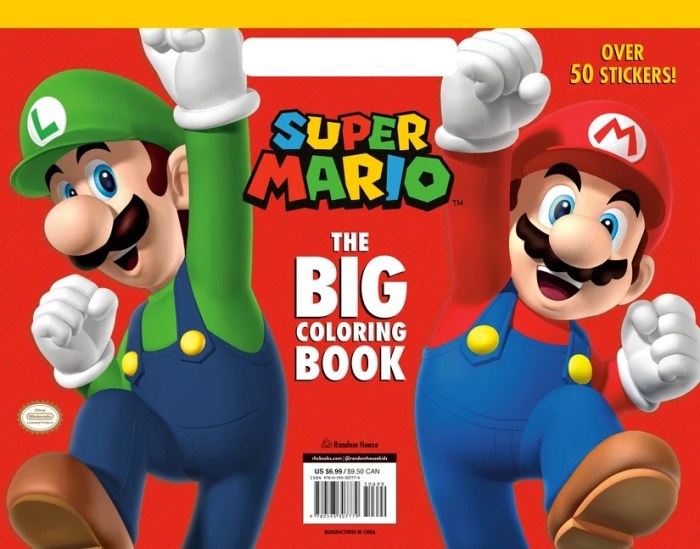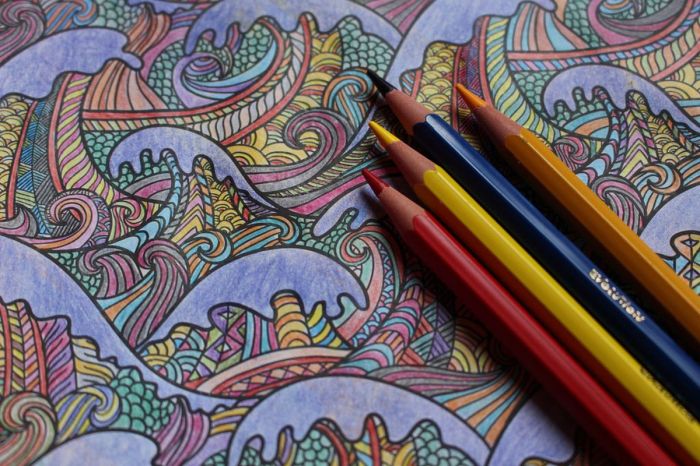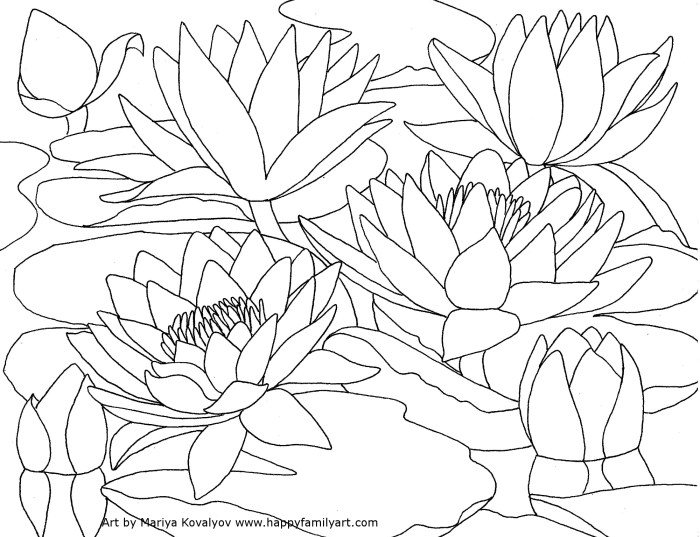Market Analysis of “Super Mario Coloring Book”
Super mario coloring book – The Super Mario franchise enjoys enduring popularity across multiple generations, making a coloring book a potentially lucrative venture. This analysis explores the target market, competitive landscape, and potential product variations to inform strategic decisions.
Super Mario coloring books offer a vibrant world of adventure for young artists. For a different railway-themed creative experience, consider the charming illustrations available in a thomas the train printable coloring book ; it’s a fun alternative if you’re looking for something beyond the Mushroom Kingdom. Returning to Mario, the iconic characters and recognizable settings make for hours of enjoyable coloring.
Target Audience
The primary target audience for a Super Mario coloring book spans a broad age range, primarily encompassing children aged 4-10 years old. Within this range, there are distinct segments. Younger children (4-6) will likely gravitate towards simpler designs featuring iconic characters like Mario, Luigi, and Toad. Older children (7-10) might prefer more intricate illustrations depicting scenes from the games, perhaps including enemies like Goombas and Koopa Troopas, or showcasing complex environments like castles or underwater levels.
Beyond children, the nostalgic appeal of Super Mario could also attract adult collectors or those seeking a relaxing creative outlet. The marketing strategy should consider this dual audience, with potentially different designs and complexity levels catering to each segment.
Key Competitors and Pricing Strategies
The children’s coloring book market is highly competitive. Three key competitors include Crayola, Disney, and Nickelodeon. Crayola, known for its wide range of art supplies, often offers coloring books at a mid-range price point, typically between $5 and $10 depending on size and features. Disney, leveraging its extensive portfolio of characters, tends to position its coloring books at a slightly higher price point, reflecting the brand’s premium image and potentially more elaborate designs.
Nickelodeon, similarly employing popular characters, also operates within a mid-range pricing strategy, often competing directly with Crayola on price and design complexity.
Comparison of Super Mario Coloring Books
The following table compares hypothetical features of three different Super Mario coloring books, illustrating potential variations in product offerings. These are illustrative examples and not necessarily reflective of actual products on the market.
| Feature | Super Mario Adventure | Super Mario Kart Race | Super Mario Galaxy |
|---|---|---|---|
| Number of Pages | 32 | 48 | 64 |
| Size (inches) | 8.5 x 11 | 11 x 14 | 8.5 x 11 |
| Paper Quality | Standard | Thick, glossy | Thick, perforated |
| Price (USD) | $6.99 | $9.99 | $12.99 |
Illustrative Elements & Design Considerations: Super Mario Coloring Book

Creating a successful Super Mario coloring book requires careful consideration of the artistic style and overall design. The illustrations must capture the essence of the beloved game while remaining engaging and easy for children to color. A balance between simplicity and detail is crucial to ensure broad appeal.The artistic style should be bright, cheerful, and reminiscent of the classic Super Mario games.
A slightly simplified, cartoonish style works best, avoiding overly complex details that might frustrate young colorists. Maintaining consistency with the game’s established visual identity—the recognizable character designs, environments, and iconic items—is paramount. Think bold Artikels, vibrant colors, and a generally playful aesthetic. This ensures immediate recognition and appeals to both longtime fans and newcomers alike.
Cover Design Options, Super mario coloring book
Three distinct cover designs can effectively showcase the coloring book’s content and target audience.
- Design 1: Classic Mario Adventure. This cover features Mario and Luigi standing triumphantly before a colorful, iconic background such as Bowser’s Castle or a lush landscape from the Mushroom Kingdom. The characters are depicted in a dynamic pose, perhaps mid-jump or celebrating a victory. The title “Super Mario Coloring Book” is prominently displayed in a playful font, possibly incorporating elements like stars or coins.
The overall aesthetic is vibrant and action-packed, appealing to children who love the thrill of adventure. The color palette is bright and bold, using the classic red, blue, green, and yellow associated with Mario.
- Design 2: Cute and Cuddly Characters. This design focuses on the softer, more endearing aspects of the Mario universe. It might feature chibi-style versions of Mario, Luigi, Peach, and Toad engaged in playful activities. The background could be a pastel-colored scene, perhaps a picnic or a tea party. The title is written in a softer, rounder font, emphasizing the cuddly nature of the characters.
This design targets a younger audience, appealing to children who appreciate adorable and whimsical imagery. The color palette is softer, with pastel shades and muted tones.
- Design 3: Iconic Item Focus. This cover showcases a collection of iconic Super Mario items, such as power-ups (Super Mushroom, Fire Flower, Super Star), coins, and blocks. These elements are arranged in a visually appealing and dynamic composition, perhaps forming a recognizable shape or pattern. The title is incorporated subtly, perhaps woven into the design itself. This design offers a more abstract and visually stimulating approach, attracting children who appreciate visual puzzles and patterns.
The color palette is bright and varied, emphasizing the diversity of the game’s iconic items.
Potential Bonus Features
Adding bonus features can significantly enhance the coloring book’s appeal and value.
- Stickers: A sheet of peel-and-stick stickers featuring Mario, Luigi, Princess Peach, Bowser, and other popular characters and items. These can be used to decorate the completed coloring pages or other items.
- Stencils: A set of reusable stencils featuring various shapes and characters from the game, allowing children to easily trace and create their own Mario-themed artwork.
- Mini-Games: Simple, printable mini-games related to the Mario universe, such as mazes, spot-the-difference puzzles, or simple word searches. These offer an added layer of interactive entertainment.
- Coloring Page Templates: Blank templates of iconic scenes or characters for children to freely design and color.
- Fact Sheet: A small information sheet featuring interesting facts about the Super Mario universe, including the history of the game, character profiles, and fun trivia.
Production and Manufacturing

Producing a high-quality Super Mario coloring book requires careful consideration of printing methods, paper selection, and the overall production process. The choices made at each stage significantly impact the final product’s cost, durability, and visual appeal, ultimately influencing its success in the market.Printing methods, paper selection, and the production workflow are all crucial elements in achieving a successful final product.
Balancing cost-effectiveness with quality is key to creating a coloring book that appeals to both children and parents.
Printing Methods and Associated Costs
Several printing methods are suitable for a children’s coloring book, each offering a different balance between cost and quality. Offset printing, while offering high-quality results and vibrant colors ideal for showcasing the Super Mario characters, is typically more expensive for smaller print runs. Digital printing, on the other hand, is cost-effective for smaller quantities, but the print quality might be slightly lower, particularly regarding color vibrancy and detail.
Screen printing, a simpler method, could be considered for specific elements like a cover design, but it’s less versatile for detailed illustrations within the book. The choice depends on the desired print run size and the budget allocated. For example, a large print run of 100,000 copies might favor offset printing for its cost-effectiveness per unit, while a smaller initial run of 5,000 copies might be better suited to digital printing to minimize upfront investment.
Paper Types for Children’s Coloring Books
The choice of paper significantly impacts the coloring experience. Three suitable paper types are:
- Offset Printing Paper: This offers a smooth surface ideal for crayon and colored pencil application, producing vibrant, clean colors. However, it may be thinner than other options, potentially resulting in bleed-through if water-based markers are used. The cost is moderate.
- Drawing Paper: Thicker than offset paper, drawing paper minimizes bleed-through, accommodating various coloring mediums, including markers. The heavier weight adds to the book’s durability. However, it is generally more expensive than offset paper.
- Cardstock: The thickest option, cardstock offers exceptional durability and resistance to tearing, making it ideal for younger children. It can handle various coloring tools without significant bleed-through. The high thickness and durability come at a higher cost compared to offset or drawing paper.
Production Process Steps
The production process involves several key steps:
- Design Finalization: This involves refining the artwork, ensuring color accuracy, and preparing the files for printing.
- Pre-press Preparation: This includes creating printing plates (for offset printing) or preparing digital files (for digital printing), and checking for any errors.
- Printing: The actual printing of the coloring book pages, ensuring consistent color and image quality.
- Quality Control: Inspecting the printed pages for any defects or inconsistencies.
- Cutting and Folding: Cutting the printed sheets to the correct size and folding them as needed.
- Binding: The pages are bound together, typically using saddle-stitch binding (stapling) for a cost-effective solution, or perfect binding (gluing) for a more professional look and feel. The choice depends on the page count and budget.
- Cover Application: Attaching the cover to the bound pages. This might involve additional printing and finishing processes for the cover, such as lamination for extra durability.



